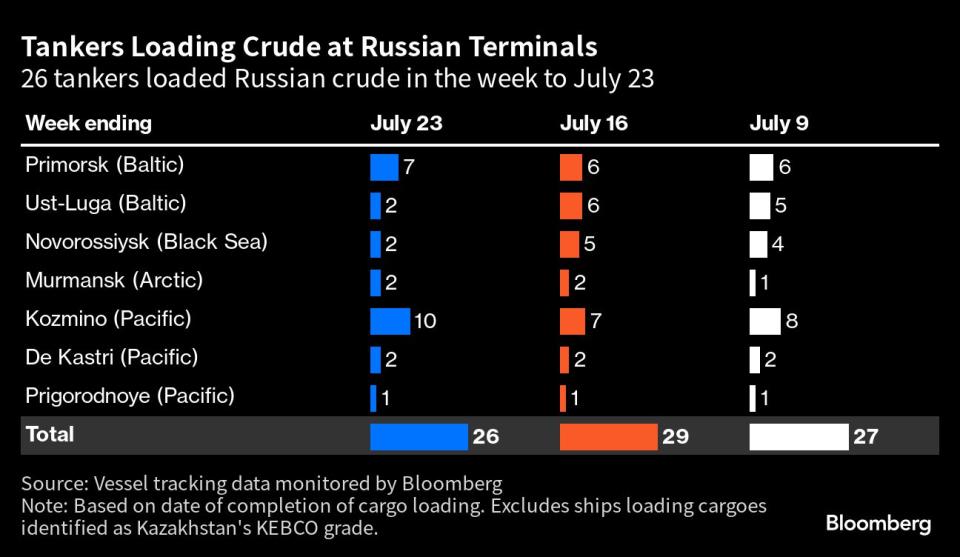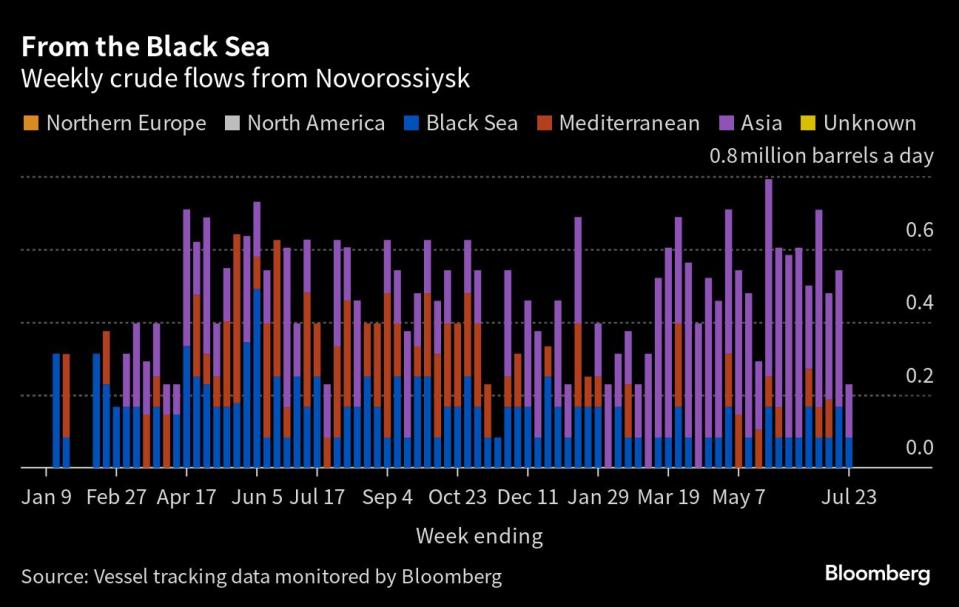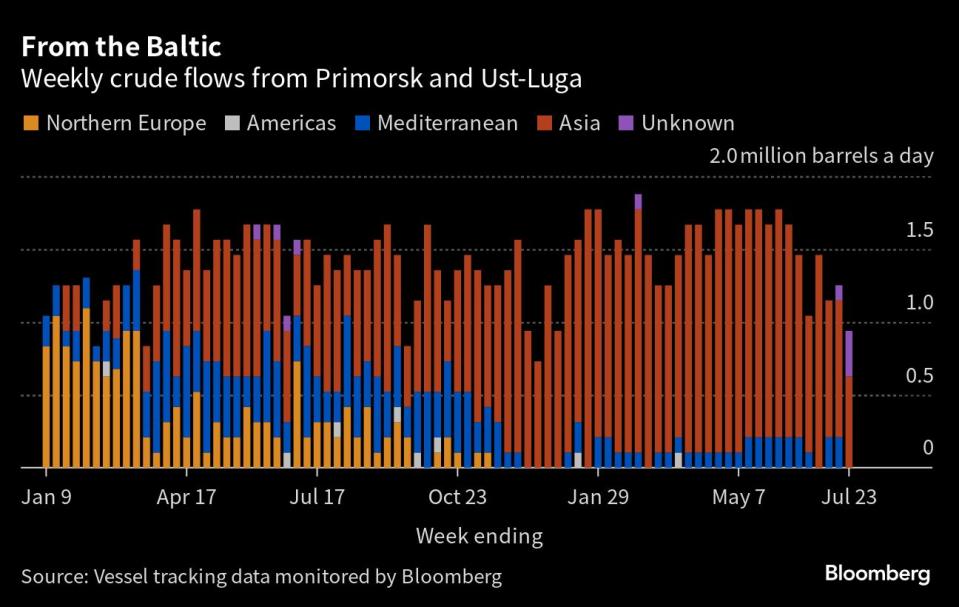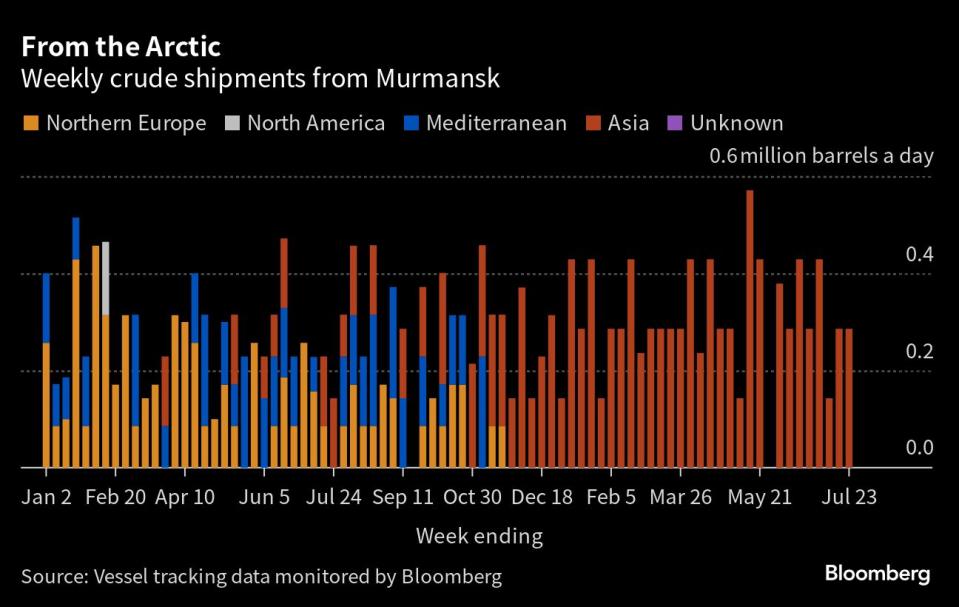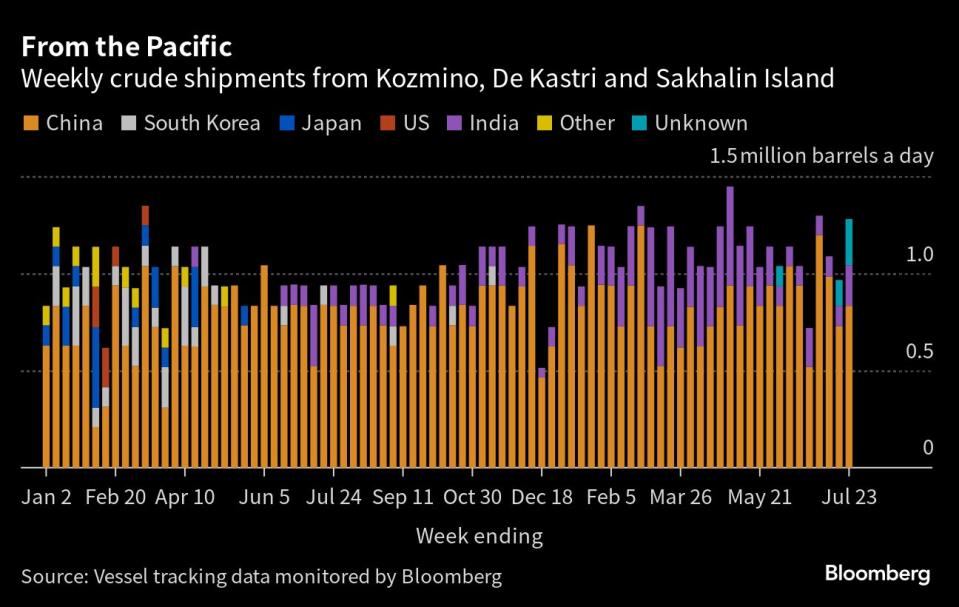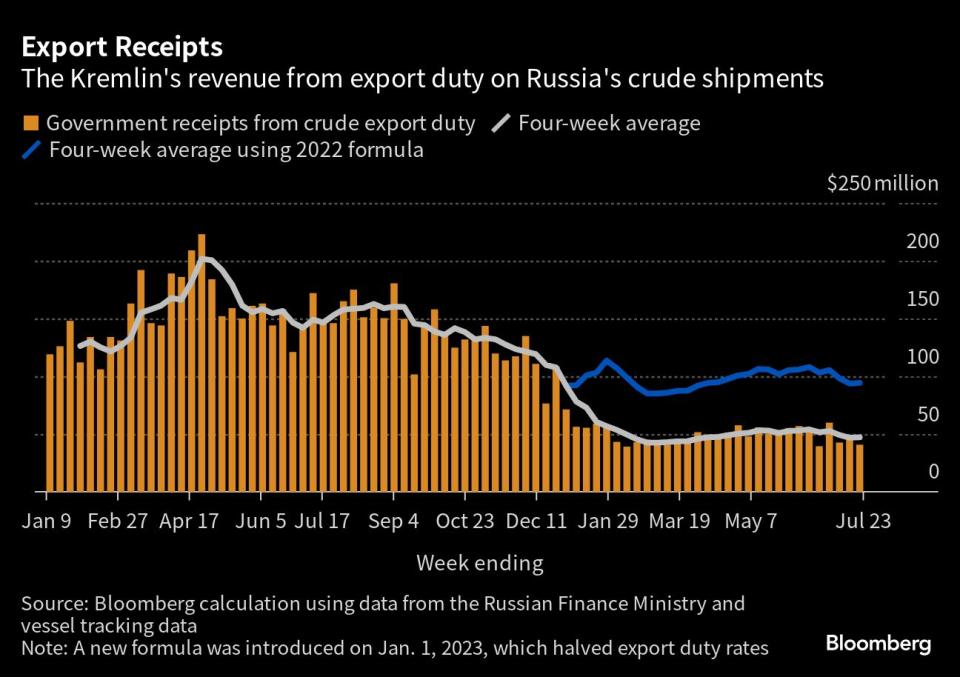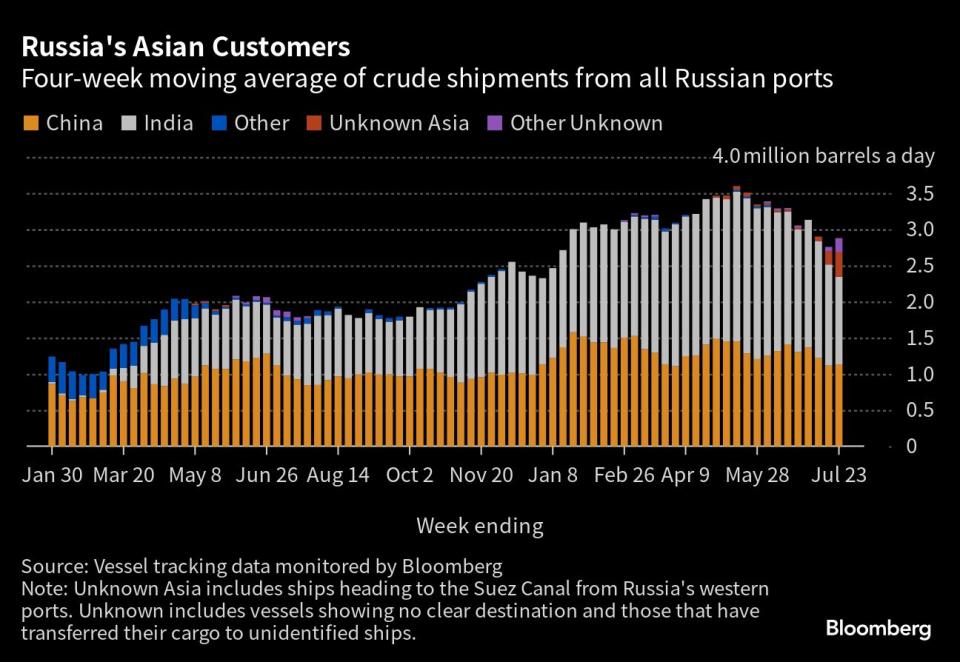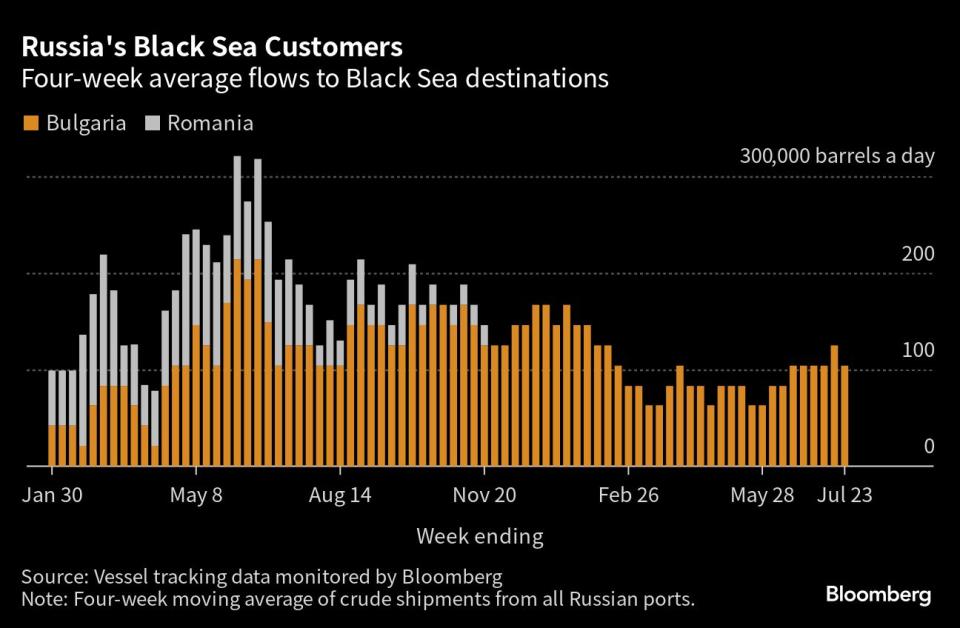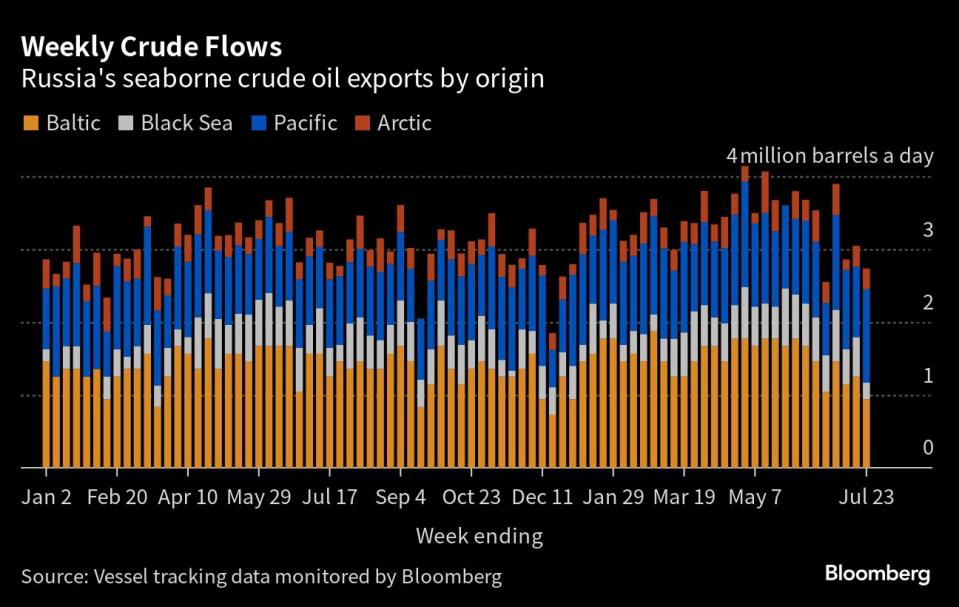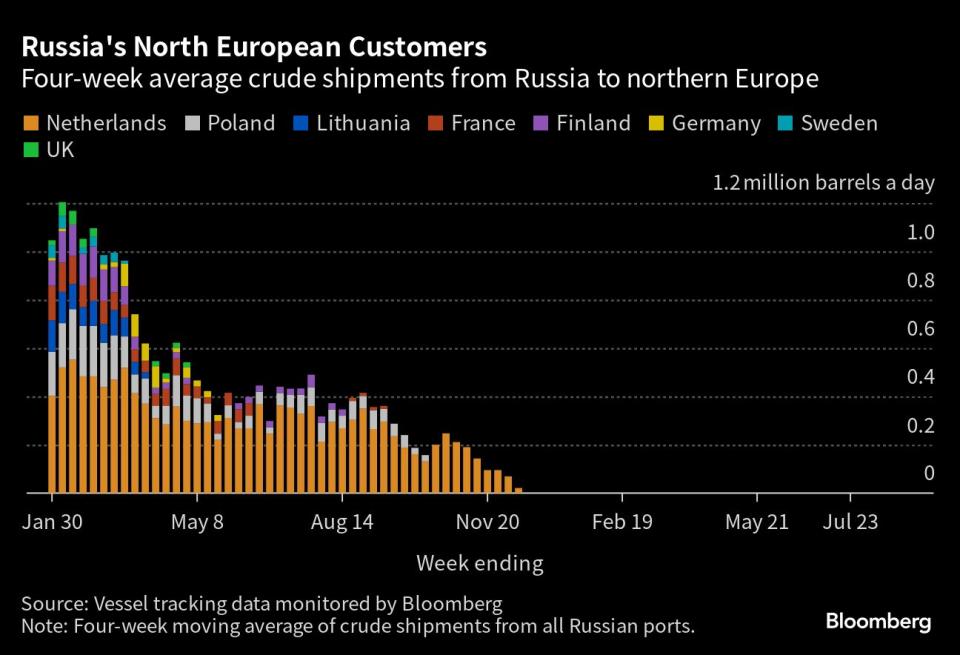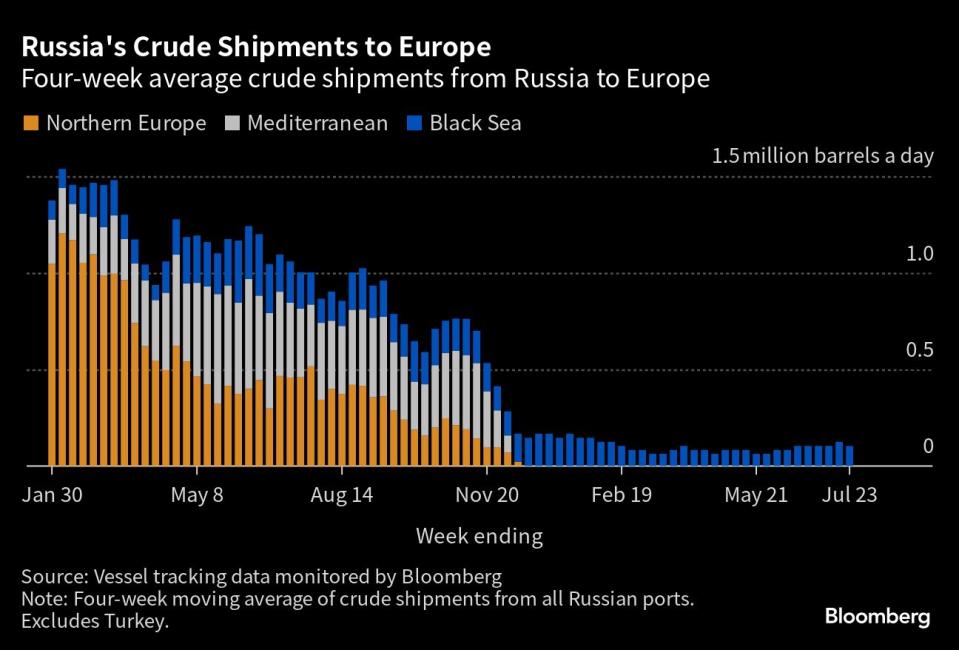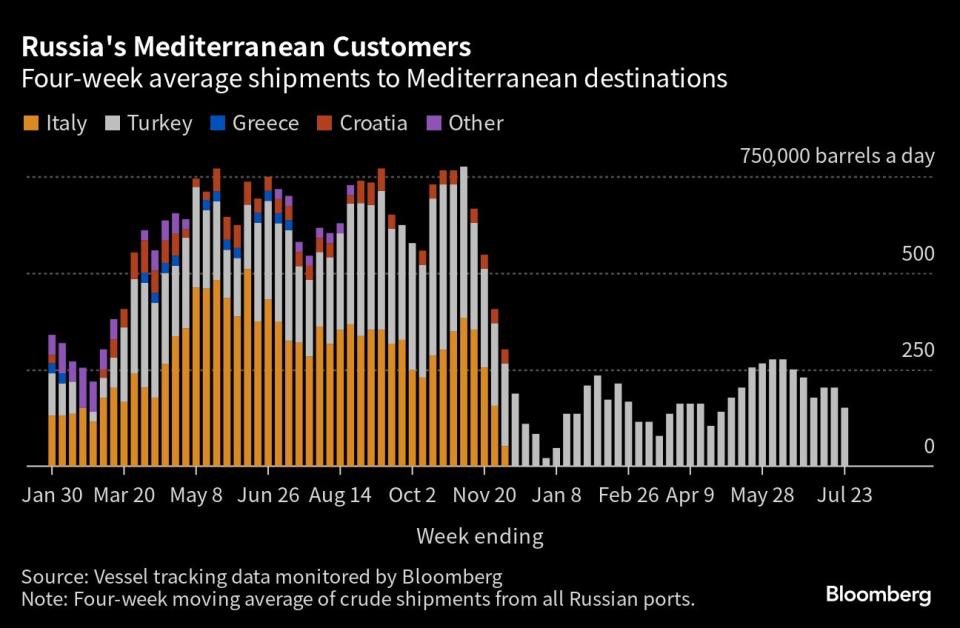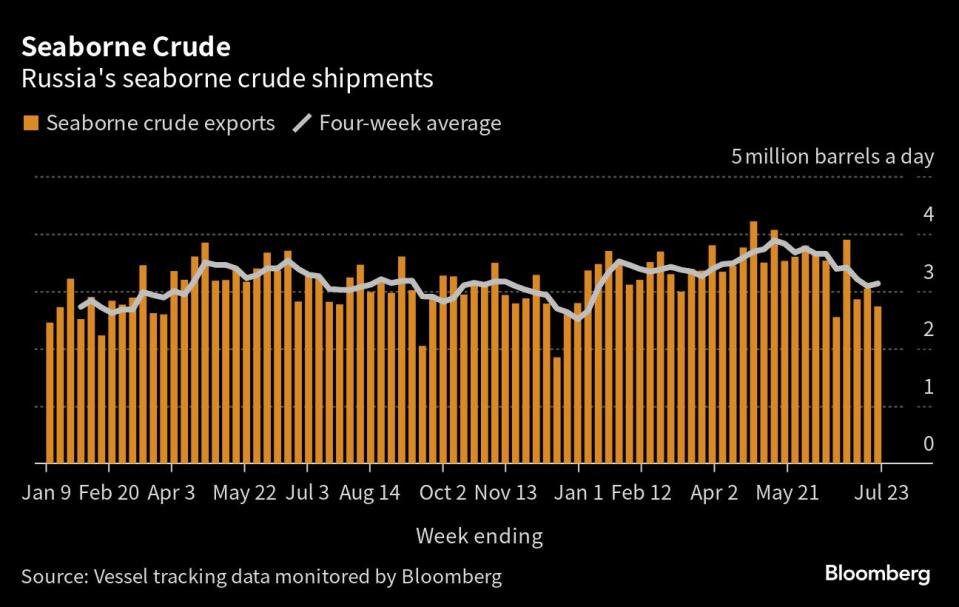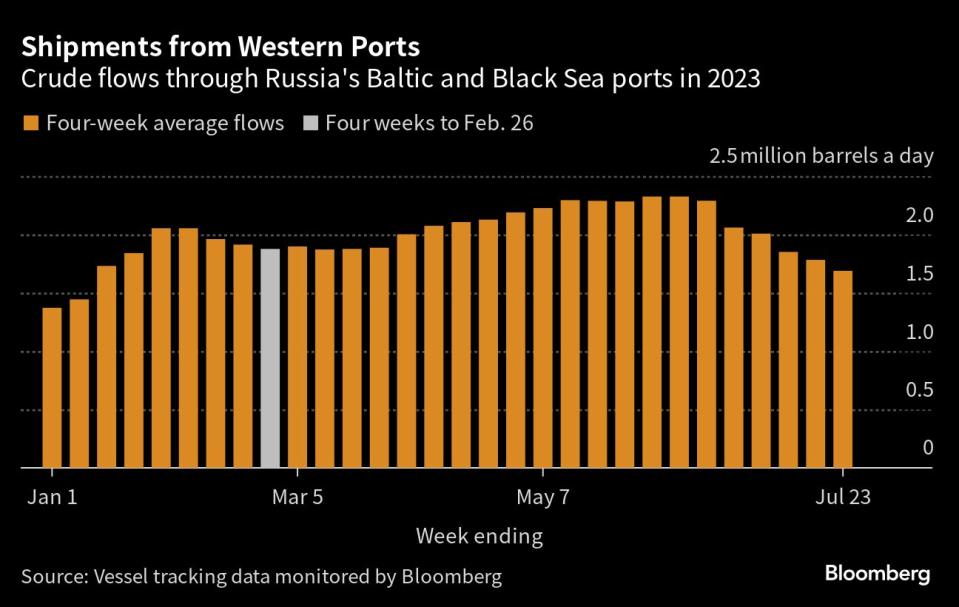Russia's Crude Flows From Western Ports Slump to Seven-Month Low
(Bloomberg) -- Russia’s seaborne crude flows from Baltic and Black Sea ports slumped to the lowest in seven months as Moscow belatedly implements cuts that it promised for March.
Most Read from Bloomberg
Rolex, Patek Prices to Keep Falling as Supplies Remain High, Morgan Stanley Says
‘We Were Wrong’: Morgan Stanley’s Wilson Offers Stocks Mea Culpa
Shipments from the ports of Primorsk, Ust-Luga and Novorossiysk fell to 1.17 million barrels a day in the week to July 23, a drop of 625,000 barrels a day from the previous week, according to vessel-tracking data monitored by Bloomberg and corroborated by other data sources.
The decline was partly offset by higher flows from Kozmino on the Pacific, but nationwide shipments still fell by 311,000 barrels a day from the previous week to 2.73 million barrels a day. They are now down by 1.48 million barrels a day from a peak in the final week of April.
The figures support the notion that Moscow is honoring a pledge to keep supply off the global market alongside its allies in the OPEC+ producer coalition. It is also an opportune time for Russia to cut shipments given a revival in domestic oil refining and soon-to-end subsidies for supplying the local market with fuel.
Russia initially said that it would cut oil production in retaliation for Western sanctions and price caps on its oil imposed after the invasion of Ukraine, using February as a baseline. But seaborne flows continued to rise, only dropping significantly in the last few weeks.
Weekly data are affected by the scheduling of tankers and loading delays caused by bad weather. Port and pipeline maintenance can also disrupt exports for several days at a time.
Four-week average shipments, which smooth out some of the volatility in the weekly numbers, edged up as the very low shipments seen in the seven days to June 25 dropped out of the calculation, though the effect was partly offset by a slump in shipments from Ust-Luga last week. The figure is expected to drop again next week when it ceases to be affected by the very high flow of crude seen in the week to July 2.
The reduced availability of Russian crude alongside fewer barrels from the Middle East has narrowed discounts offered for ESPO crude deliveries to Chinese buyers for September delivery. Rising prices and a narrowing discount against international benchmarks is also making Russia’s crude less attractive to Indian refiners, who are in talks with traditional Middle East exporters for increased purchases as Russian imports lose their pricing edge.
Overseas shipments of Russian crude from Baltic and Black Sea ports increased after the output cut was due to come into effect, peaking in late May. The reduction being seen now comes after fellow OPEC+ oil producer extended its own unilateral output cut. Russia’s export curtailment was hailed as meaningful by Saudi Energy Minister Prince Abdulaziz bin Salman, who had urged Moscow to provide greater transparency on its oil flows.
Urals prices have breached a price cap set by the Group of Seven nations, which could complicate shipments. Russian crude cannot be transported on Western ships — or make use of Western services — unless it is priced under the $60 a barrel threshold. Prices above that level will force buyers to use the shadow fleet of vessels that operate without Western insurance or other services.
Shipping firms relying on Western services can expect delays from financial and technical service providers to check the shipments weren’t sold above the G7 price cap, according to the Standard Club, a protection and indemnity provider for shipowners.
Crude Flows by Destination
With few buyers left in Europe, the impact of the lower flows is being felt in shipments to Asia, which remain near their lowest since mid-January.
On a four-week average basis, overall seaborne exports to Asian countries, plus the volumes on ships showing no final destination, have fallen by 720,000 barrels a day since mid-May.
All figures exclude cargoes identified as Kazakhstan’s KEBCO grade. Those are shipments made by KazTransoil JSC that transit Russia for export through the Baltic ports of Ust-Luga and Novorossiysk.
The Kazakh barrels are blended with crude of Russian origin to create a uniform export grade. Since Russia’s invasion of Ukraine, Kazakhstan has rebranded its cargoes to distinguish them from those shipped by Russian companies. Transit crude is specifically exempted from European Union sanctions.
Asia
Most Read from Bloomberg
Four-week average shipments to Russia’s Asian customers, plus those on vessels showing no final destination, rose to 2.88 million barrels a day in the period to July 23 from a revised 2.76 million barrels a day in the four weeks to July 16, recovering most of the previous week’s loss.
Most of the cargoes on ships without an initial destination eventually end up in India. Even so, the volumes heading to the country that has become the biggest buyer of Russia’s seaborne crude are down from their recent highs. Adding the “Unknown Asia” and “Other Unknown” volumes to the total for India gives a figure of 1.75 million barrels a day in the four weeks to July 23. That’s down from a high of 2.2 million barrels a day in the four weeks to May 21.
The equivalent of 335,000 barrels a day was on vessels showing destinations as either Port Said or Suez in Egypt, or which already have been or are expected to be transferred from one ship to another off the South Korean port of Yeosu. Those voyages typically end at ports in India or China and show up in the chart below as “Unknown Asia” until a final destination becomes apparent.
The “Other Unknown” volumes, running at 197,000 barrels a day in the four weeks to July 23, are those on tankers showing no clear destination. Most of those cargoes originate from Russia’s western ports and go on to transit the Suez Canal, but some could end up in Turkey, while other cargoes are transferred from one vessel to another, either in the Mediterranean or, more recently, in the Atlantic Ocean.
Europe
Most Read from Bloomberg
Russia’s seaborne crude exports to European countries edged down to 104,000 barrels a day in the 28 days to July 23, with Bulgaria the sole destination. These figures do not include shipments to Turkey.
A market that consumed about 1.5 million barrels a day of short-haul seaborne crude, coming from export terminals in the Baltic, Black Sea and Arctic has been lost almost completely, to be replaced by long-haul destinations in Asia that are much more costly and time-consuming to serve.
No Russian crude was shipped to northern European countries in the four weeks to July 23.
Exports to Turkey, Russia’s only remaining Mediterranean customer, fell to 151,000 barrels a day in the four weeks to July 23, the lowest since April. Flows to the country had topped 425,000 barrels a day in October.
Flows to Bulgaria, now Russia’s only Black Sea market for crude, fell back to 104,000 barrels a day after the previous week’s increase. Bulgaria’s parliament voted to terminate Lukoil PJSC’s 35-year lease of a terminal serving the Russian company’s refinery near the Black Sea early. The legislation must still be ratified by President Rumen Radev.
Flows by Export Location
Aggregate flows of Russian crude fell to 2.73 million barrels a day in the seven days to July 23, from a revised 3.05 million barrels a day the previous week. A big drop is shipments from Baltic and Black Sea ports was partly offset by an increase in flows from the Pacific.
The slump in flows seen from the port of Ust-Luga may have been affected by maintenance, either at the port or on the pipeline serving the facility. A similar dip in shipments was seen around this time last year, while a four-day gap in the loading program indicates that the slowdown was planned in advance.
Figures exclude volumes from Ust-Luga and Novorossiysk identified as Kazakhstan’s KEBCO grade.
Vessel-tracking data are cross-checked against port agent reports as well as flows and ship movements reported other information providers including Kpler SAS and Vortexa Ltd.
Export Revenue
Inflows to the Kremlin's war chest from its crude-export duty fell to $41 million in the seven days to July 23, an drop of $5 million or 10%. Four-week average income edged higher to just above $47 million.
Russia’s government calculates oil taxes, including export duty, using a discount to Brent, which sets the floor price for the nation’s crude for budget purposes. If Russian oil trades above that threshold, the Finance Ministry uses the market price for tax calculations, as has been the case in recent months. From July the discount is currently set at $25/bbl, but the budget and tax committee of the Russian State Duma has supported a Finance Ministry proposal to reduce the discount to $20 a barrel from September.
The duty rate for July has been set at $2.13 a barrel, based on an average Urals price of $54.57, which was $20.89 a barrel below Brent during the period between May 15 and June 14. The levy will be increased to about $2.31 a barrel for August, based on an average Urals price of $58.03, which was $18.02 a barrel below Brent during the period between June 15 and July 14.
Origin-to-Location Flows
The following charts show the number of ships leaving each export terminal and the destinations of crude cargoes from the four export regions.
A total of 26 tankers loaded 19.14 million barrels of Russian crude in the week to July 23, vessel-tracking data and port agent reports show. That’s down by 2.18 million barrels from the previous week’s figure. With the exception of the week in June when shipments from Primorsk were reduced by maintenance work, it’s the lowest export figure since December.
Circumstantial evidence suggests that work at Ust-Luga, or the pipeline serving it, may have reduced flows from the port. There was a similar drop in shipments from Ust-Luga at this time last year and a gap of several days in a loading program for the port seen by Bloomberg.
Destinations are based on where vessels signal they are heading at the time of writing, and some will almost certainly change as voyages progress. All figures exclude cargoes identified as Kazakhstan’s KEBCO grade.
The total volume on ships loading Russian crude from the Baltic terminals dropped below 1 million barrels a day for the first time since December. The slump was concentrated at Ust-Luga, where shipments fell by two-thirds from the previous week. One cargo of Kazakhstani crude was loaded at the port during the week.
Shipments of Russian crude from Novorossiysk in the Black Sea also fell, dropping to their lowest since February. One cargo of Kazakhstani crude was also loaded at the port during the week.
Arctic shipments were unchanged at 286,000 barrels a day. Two Suezmax tankers completed loading during the week ended July 23.
Thirteen tankers loaded at Russia’s three Pacific export terminals, up from 10 the previous week. The volume of crude shipped from the region rose to 1.28 million barrels a day.
Shipments from the Sakhalin Island terminal remained low last week due to maintenance at one of the Sakhalin 2 project’s oil production platforms.
The volumes heading to unknown destinations are mostly Sokol cargoes that recently have been transferred to other vessels at Yeosu, or are currently being shuttled to an area off the South Korean port from the loading terminal at De Kastri. Most of these are ending up in India.
Some Sokol cargoes are now being transferred a second time in the waters off southern Malaysia. A small number of ESPO shipments are also being moved from one vessel to another in the same area. All bar one of these cargoes have, so far, gone on to India. That one cargo was transferred onto a floating storage vessel off Malaysia, where it remains.
NOTES
Note: This story forms part of a regular weekly series tracking shipments of crude from Russian export terminals and the export duty revenues earned from them by the Russian government.
Note: All figures exclude cargoes owned by Kazakhstan’s KazTransOil JSC, which transit Russia and are shipped from Novorossiysk and Ust-Luga as KEBCO grade crude.
Note: Weeks have been revised to run from Monday to Sunday, rather than Saturday to Friday. This change has been implemented throughout the data series and previous weeks’ figures have been revised.
Note: The next update will be published on Tuesday Aug. 1, with future updates also to be published on TuesdaysIf you are reading this story on the Bloomberg terminal, click here for a link to a PDF file of four-week average flows from Russia to key destinations.
--With assistance from Sherry Su.
Most Read from Bloomberg Businessweek
The Stainless-Steel Boom Is Tearing a South African Mining Region Apart
No Testing, No Inspections: Contaminated Eyedrops Blinded and Killed Americans
This Supposed Mafia Manifesto Doesn’t Stand Up to a Google Search
©2023 Bloomberg L.P.

